Tarantulas are among the most misunderstood creatures. But first things first. There aren’t breeds of tarantulas. There are, however, tarantula species. And many people find the thought of keeping them as pets scary.
But for people who can look beyond their hairy look and gangly long legs, tarantulas make very great pets. Many species of tarantula are pretty resilient and are very easy to keep. If you choose to keep a pet tarantula, you won’t have to worry about feeding, cleaning, housing, and other factors that make it stressful to keep other types of household pets.
There are more than 800 species of tarantulas in the world, and up to 30 of them are native to the United States. Of all these, only a handful of tarantulas make great pets. Some species are also more suited for more experienced owners.
Here’s a comprehensive list of the different species of tarantula you can keep as a pet.
Docile New World Tarantula Species — Best For Beginners
If you’re entirely new to keeping tarantulas, you should start with docile tarantula species because they’re relatively easy to care for. Tarantulas from the western hemisphere (the Americas) are called New World tarantulas. The laid-back and easy-going nature of this group of spiders makes them relatively safe to handle compared to more aggressive varieties.
Although not all new world tarantulas are docile, the following are some of the easy-going types:
Mexican Blood Leg (Aphonopelma bicoloratum)

The Mexican blood leg is famous for its docile nature. It rarely bites and doesn’t throw hairs.
©Wuttipat Jathutain/Shutterstock.com
This is a low-maintenance tarantula species native to Mexico. It is a ground-dwelling spider fond of digging into the substrate. The Mexican blood leg is famous for its docile nature. It rarely bites and doesn’t throw hairs. While their gentle nature makes them good pets, they tend to be expensive due to their rarity. They can live for up to 20–25 years.
Desert Blond (Aphonopelma chalcodes)
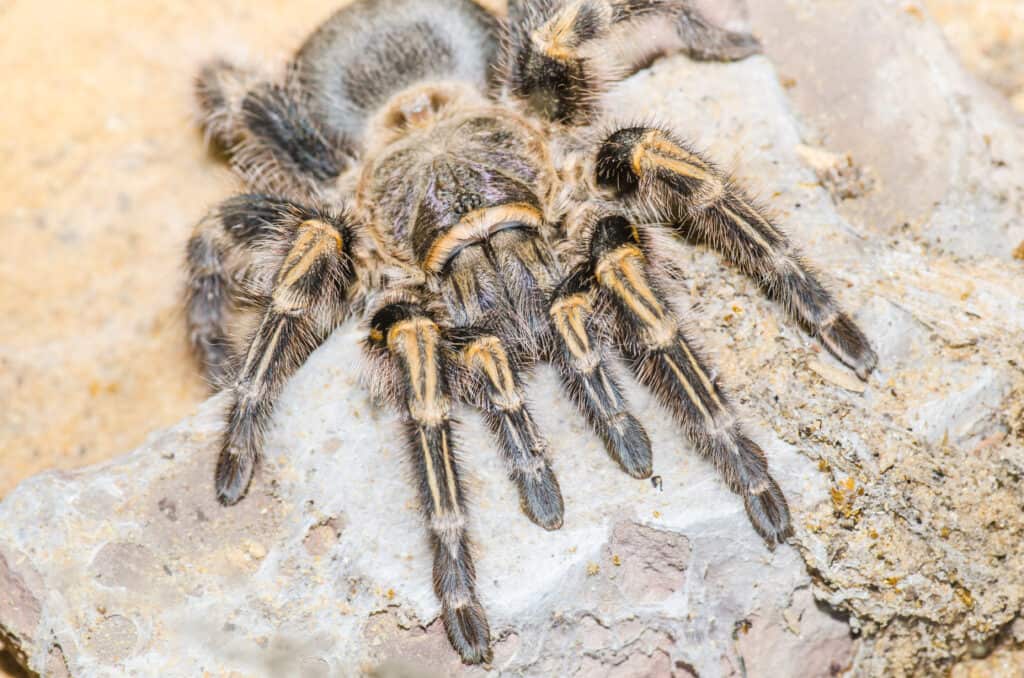
In addition to being docile, Desert Blond’s (
Aphonopelma chalcodes) venom is relatively mild compared to other spider species.
©KobchaiMa/Shutterstock.com
The “not-so-aggressive” Mexican blonde tarantula is another excellent option for spider keepers with limited experience. In addition to being docile, their venom is relatively mild compared to other spider species. The desert blond can live for up to 30 years.
Costa Rican Zebra (Aphonopelma seemani)
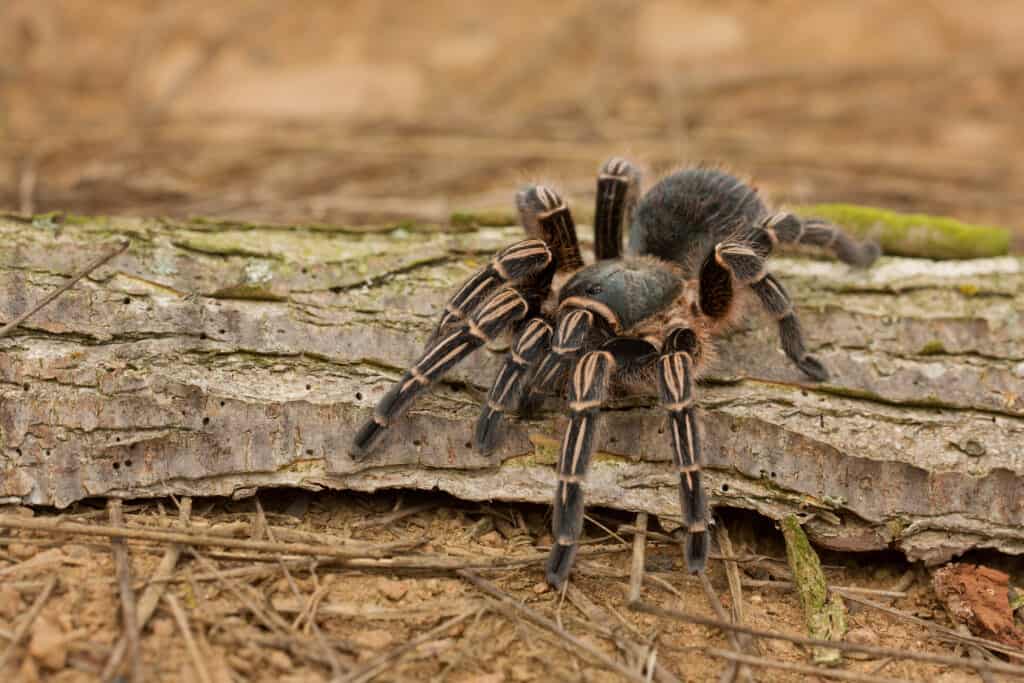
Although it can move very fast, the Costa Rican zebra is calm and hardly ever problematic.
©Milan Zygmunt/Shutterstock.com
This is a calm ground-dwelling tarantula that prefers warm, humid habitats. Although it can move very fast, the Costa Rican zebra is calm and hardly ever problematic. Females can live for up to 20 years in the right conditions.
Common Pink Toe (Avicularia avicularia)
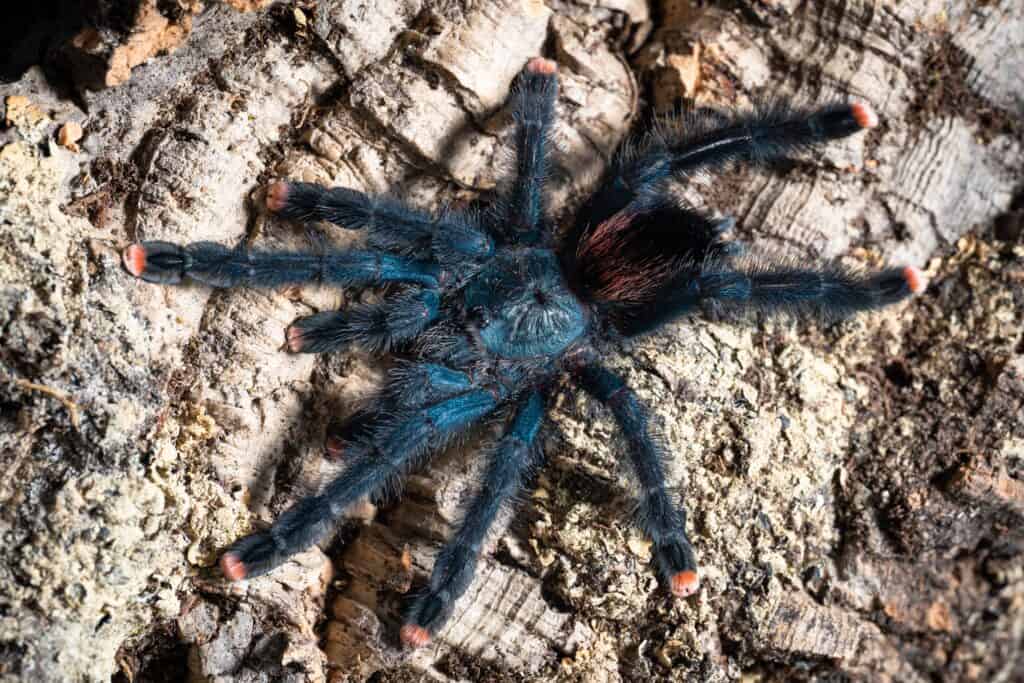
Although they’re great pets, the South American pink toe has a short lifespan of 6-9 years.
©tempisch/Shutterstock.com
Also known as South American pink toe, this is a tree-dwelling tarantula species. They’re not aggressive. In fact, their initial reaction when threatened is to leap or run away. Although they’re great pets, this spider has a short lifespan of 6-9 years.
Mexican Redleg (Brachypelma emilia)
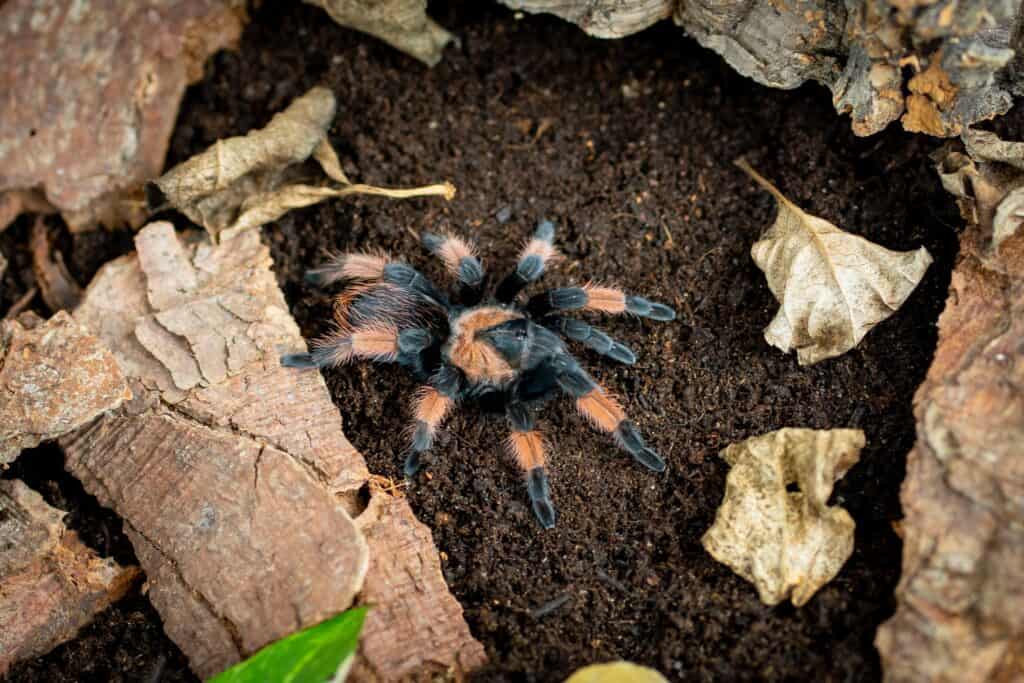
Mexican redleg tarantula
Brachypelma emiliaare ground-dwelling spiders and are relatively docile.
©tempisch/Shutterstock.com
Mexican redlegs are among the longest-living tarantula species, with an average lifespan of 30 years. They’re ground-dwelling spiders and are relatively docile. However, they tend to get startled easily, so you have to be careful around them.
Amazon Sapphire Pink Toe (Avicularia diversipes)
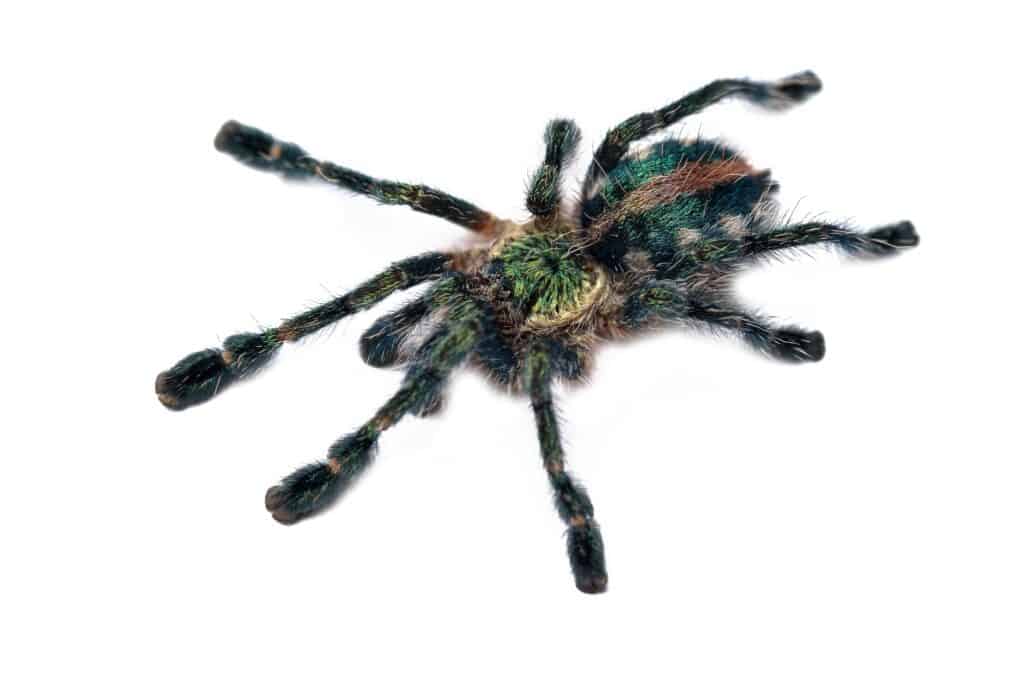
The Amazon Sapphire Pink Toe spider also has a calm demeanor, making them desirable for beginners.
©D. Kucharski K. Kucharska/Shutterstock.com
This is one of the most colorful tarantula species desirable for its unique appearance. They’re easy to keep, and they grow very quickly. This beautiful spider also has a calm demeanor, making them desirable for beginners.
Other Docile New World Species Include
- Brazilian Pink Toe (Avicularia geroldi)
- Puerto Rican Pink Toe (Avicularia laeta)
- Venezuelan Red Slate Pink Toe (Avicularia minatrix)
- Mexican Red-Knee (Brachypelma smithi)
- Pink Zebra Beauty (Eupalaestrus campestratus)
Skittish and Defensive New World Species
Although new world tarantula species are generally not aggressive, some aren’t quite as docile as others. However, they still make great pets for inexperienced tarantula keepers. You only need to know how to handle them with care.
Mexican Redrump (Brachypelma vagans)
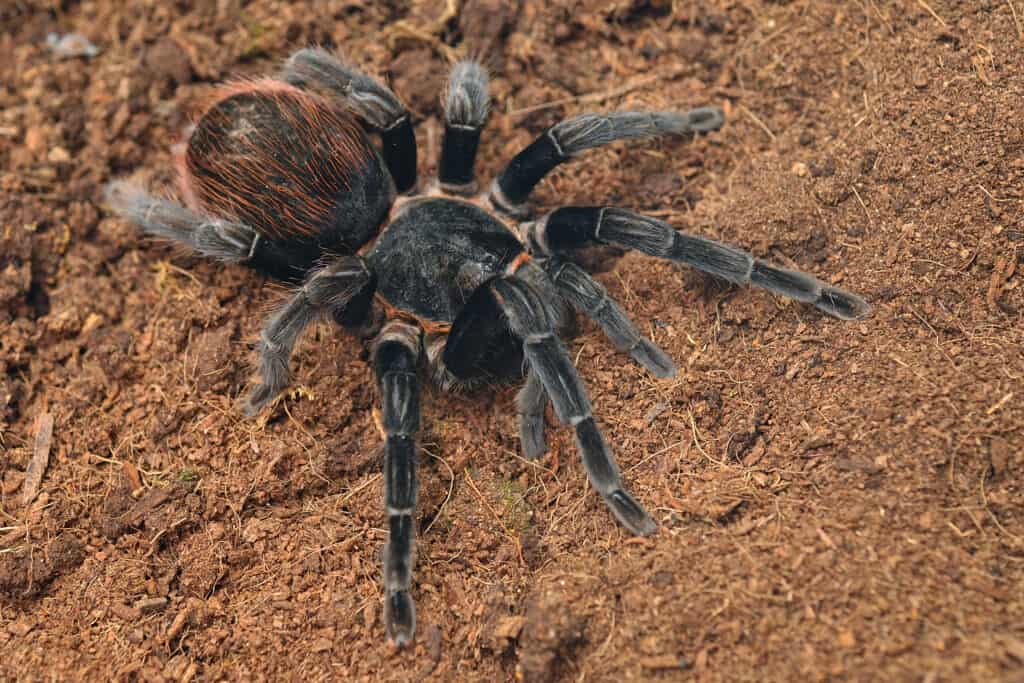
This ground-dwelling spider (Mexican redrump) tends to make burrows and tunnels in their substrate.
©D. Kucharski K. Kucharska/Shutterstock.com
As the name suggests, the Mexican redrump is characterized by a red-colored abdomen, while the rest of its body is dark brown or black. This ground-dwelling spider tends to make burrows and tunnels in their substrate. If you intend to keep them as pets, you need to keep this in mind.
Green Bottle Blue (Cromatopelma cyanopubescens)
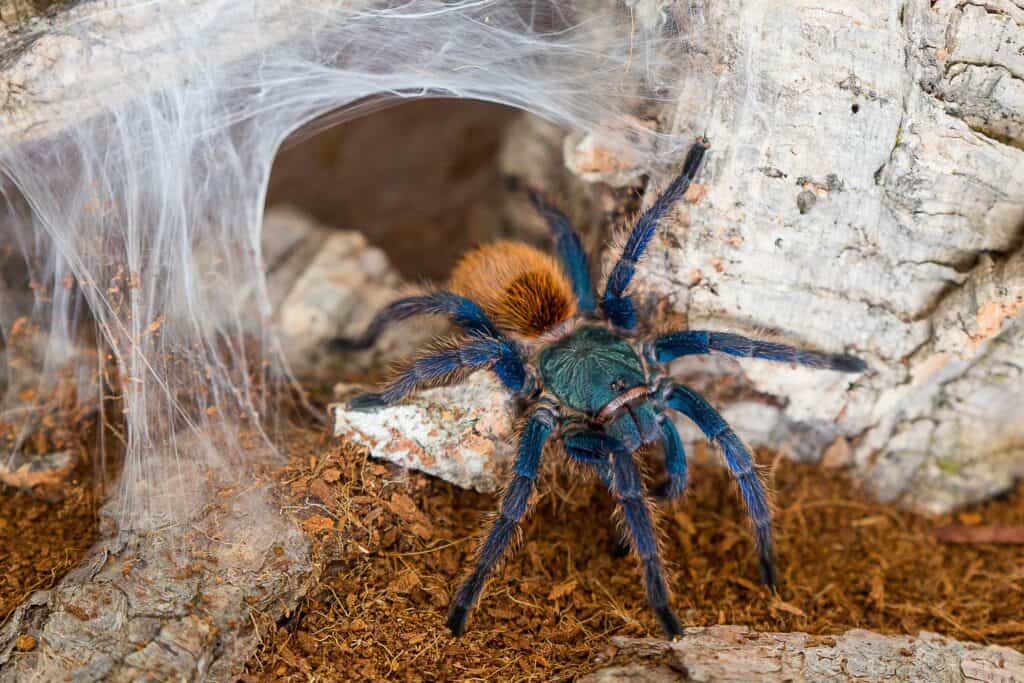
Although the Green Bottle Blue (
Cromatopelma cyanopubescens) spider rarely attacks, it is pretty skittish and does not like to be handled.
©tempisch/Shutterstock.com
This tarantula has a remarkable green, blue and orange body. The impressive appearance of this spider and its non-aggressive nature are the major reasons it is so popular. Although this spider rarely attacks, it is pretty skittish and does not like to be handled.
Brazilian Black (Grammostola pulchra)
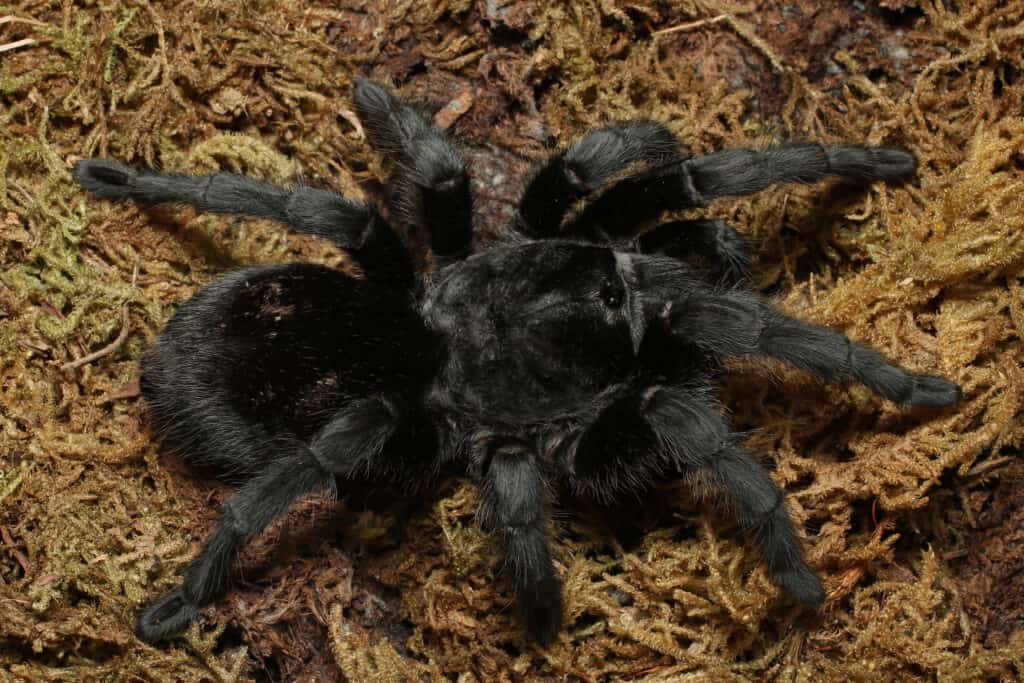
A brilliantly black and large leg-span spider, the Brazilian Black tarantula makes for a strikingly pretty pet.
©Dan Olsen/Shutterstock.com
Known for its silky black color, the Brazilian black tarantula is one of the most mild-tempered tarantula species you can keep as a pet. They’re slow growing, with a relatively long lifespan.
Goliath Birdeater (Theraphosa blondi)
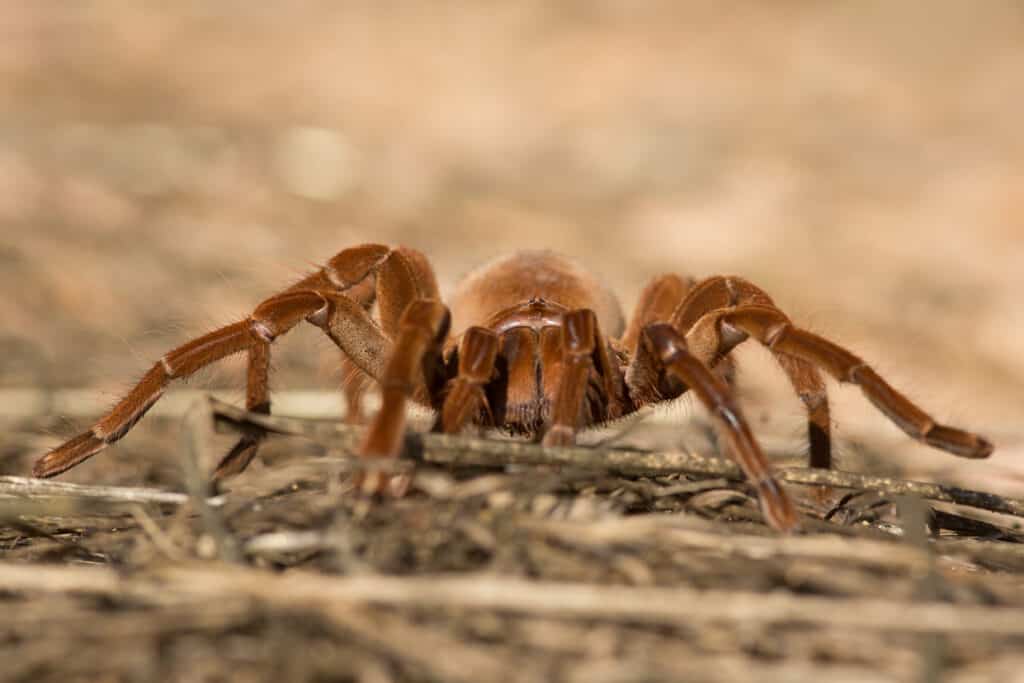
Found in northern South America, the Goliath bird-eating spider is the largest spider in the world by mass and size. They live for 15–25 years on average.
©Milan Zygmunt/Shutterstock.com
You’ll need a bigger enclosure for this one. The Goliath bird-eating spider is the biggest tarantula species in the world. It is a relatively docile spider but may attack in self-defense. Although it has massive fangs, the Goliath’s venom is relatively harmless to humans. They live for 15–25 years on average.
Blue Fang Skeleton (Ephebopus cyanognathus)
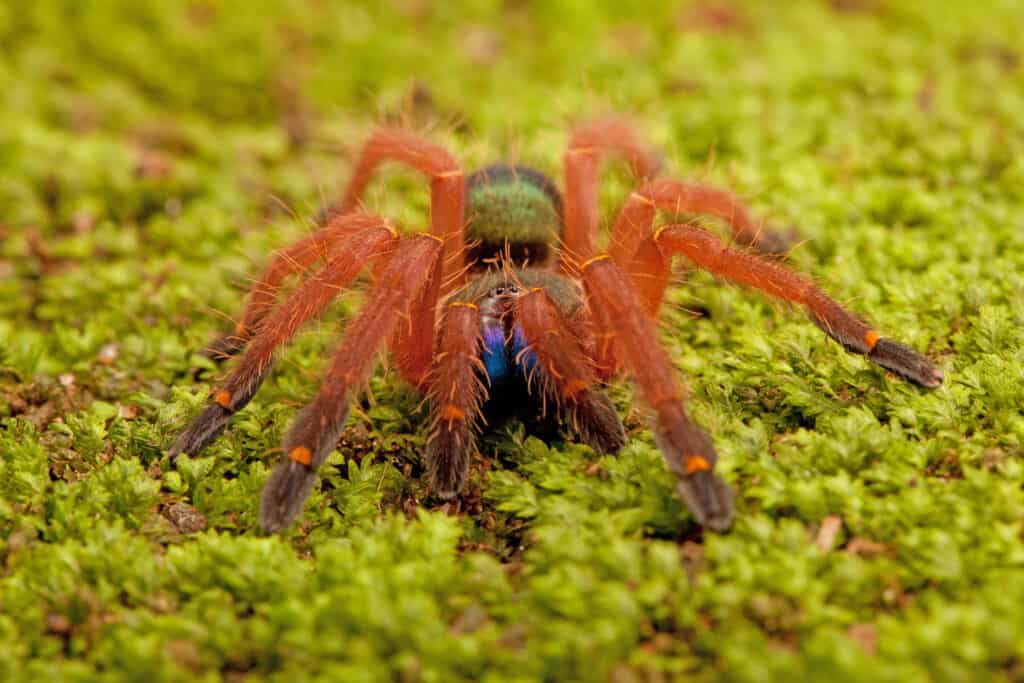
The Blue Fang Skeleton Tarantula is quite common in French Guiana and is commonly kept as a pet there.
©Linn Currie/Shutterstock.com
The blue fang skeleton tarantula is famous for its attractive blue fang. As juveniles, this spider is skittish and defensive. However, they get calmer and more confident as they get older. This ground-dwelling spider is quite common in French Guiana and is commonly kept as a pet there.
Other Skittish And Defensive New World Tarantula Species
- Skeleton Leg (Ephebopus murinus)
- Red Skeleton (Ephebopus rufescens)
- Salmon Pink Birdeater (Lasiodora parahybana)
- Columbian Giant Redleg (Megaphobema robustum)
- Panama Blond (Psalmopoeus pulcher)
- Mexican Rustleg (Brachypelma boehmei)
- Chilean Rose Hair (Grammostola rosea)
Territorial Old World Species
Old-world tarantula species are known for their potent venom and aggressive nature. They’re faster than new world spiders and are not afraid of confrontation. This makes them challenging to keep compared to the new world varieties. Examples of highly territorial tarantula species include:
Orange Baboon Tarantula (Pterinochilus murinus)
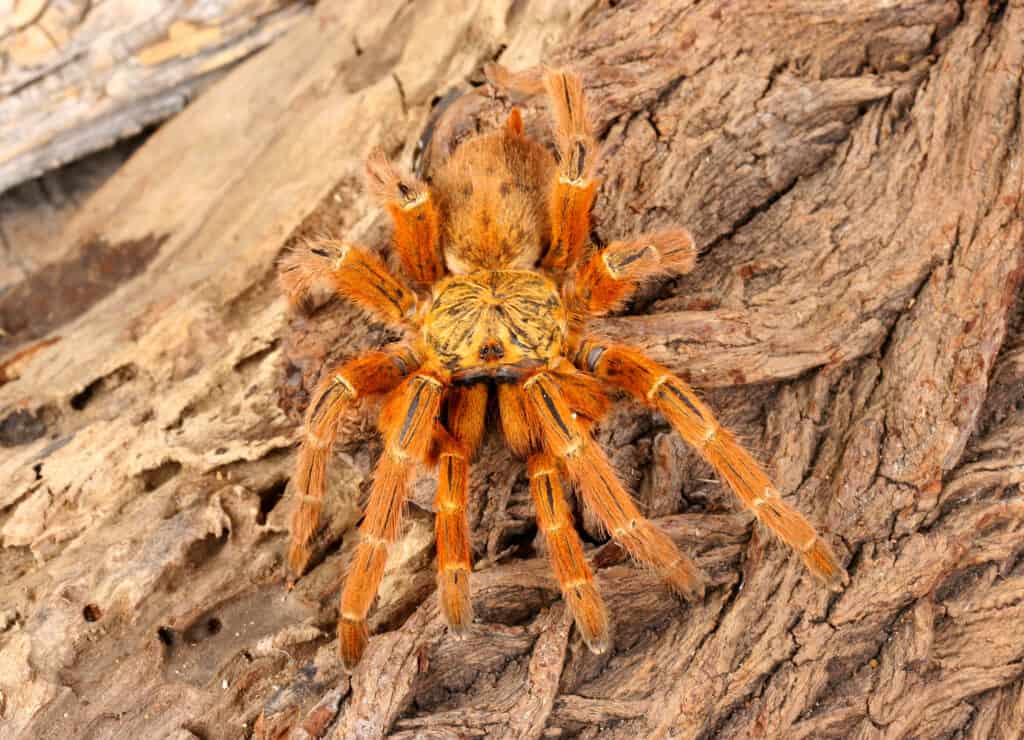
The Usambara Orange Baboon Tarantula (
Pterinochus murinus) is native to
Africa
.
©Audrey Snider-Bell/Shutterstock.com
This tarantula is also known as the “orange bitey thing.” The nickname gives you a clear picture of what experts think of this tarantula species. Native to Africa, this tarantula species can deliver an excruciating but non-fatal bite.
Indian Violet (Chilobrachys fimbriatus)
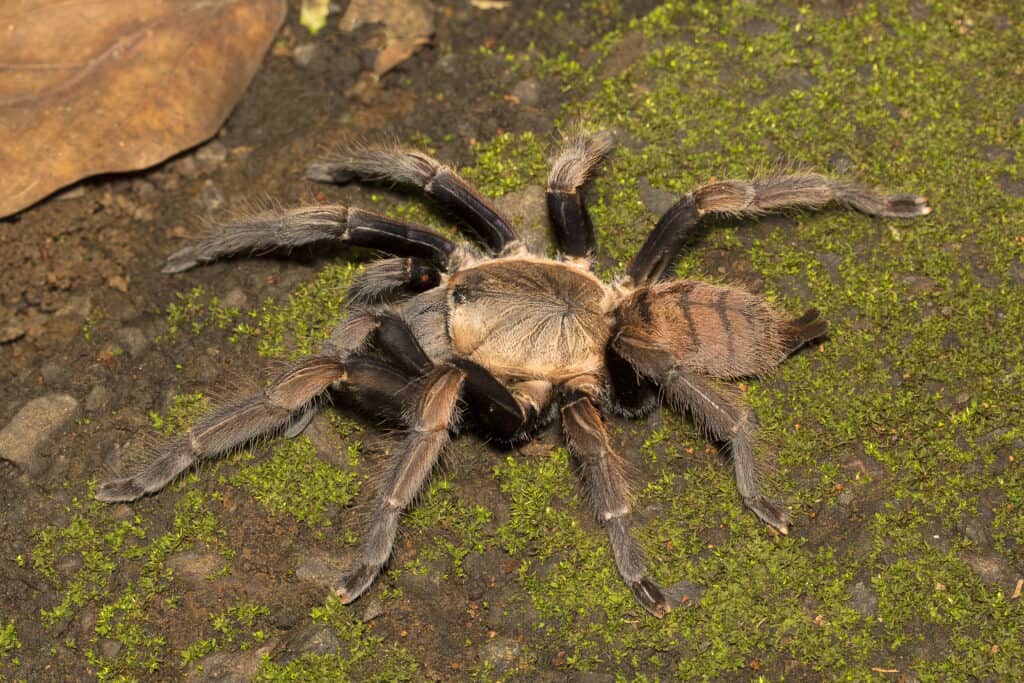
Indian violets avoid confrontation but will attack with a painful bite if threatened.
©RealityImages/Shutterstock.com
This is an Asian tarantula variety known for its golden body and blueish-grayish legs. This ground-dwelling spider avoids confrontation but will attack with a painful bite if threatened.
Blue-Foot Baboon (Idiothele mira)

In the wild, the blue-foot baboon is one of the few spider species that can build a trap door to catch prey.
©Tobias Hauke/Shutterstock.com
The bright-blue color on this tarantula’s leg is its most striking feature. In the wild, the blue-foot baboon is one of the few spider species that can build a trap door to catch prey.
Cobalt Blue (Haplopelma lividum)
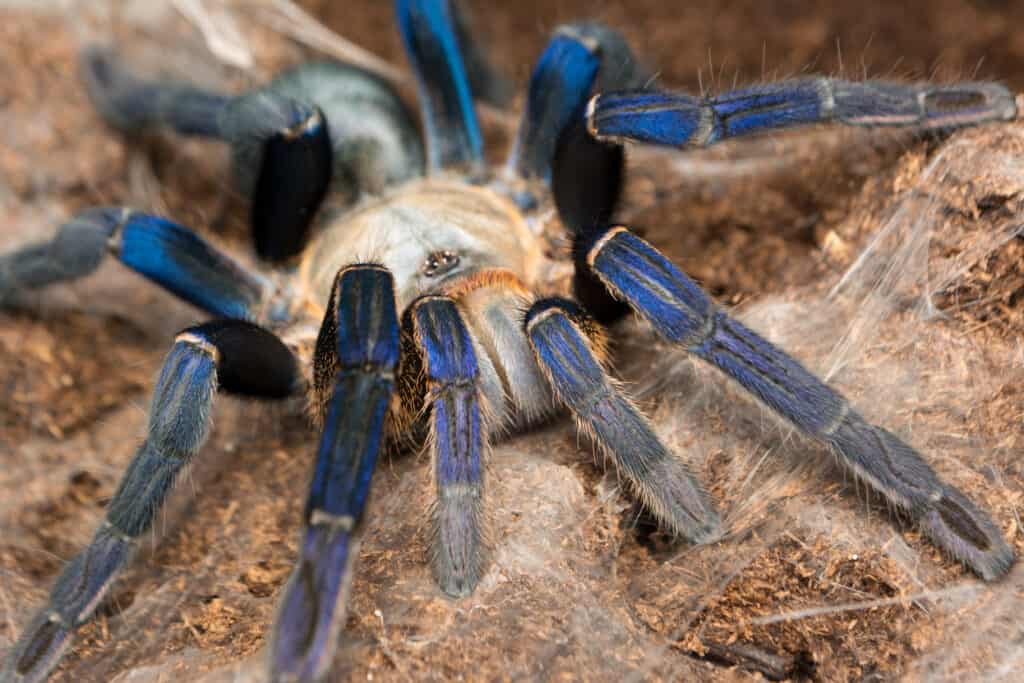
The cobalt blue tarantula is a medium size tarantula, that is fast and defensive with potent venom.
©xtotha/Shutterstock.com
This spider has a gray body with bright blue legs that glow in the dark. The striking color of this tarantula is the major reason they’re still popular as pets despite their defensive nature and potent venom.
Cameroon Baboon (Hysterocrates gigas)
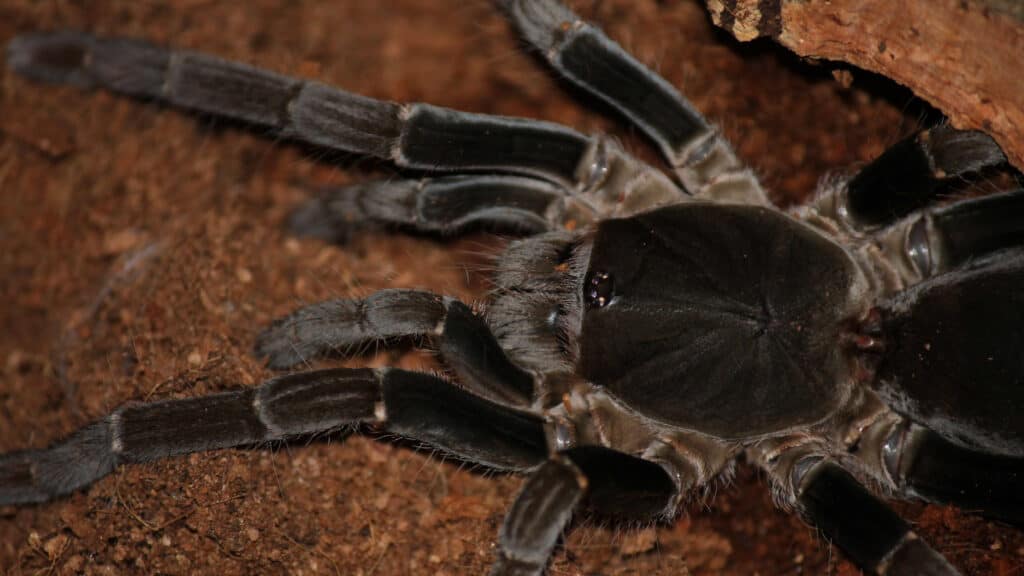
The Cameroon baboon can deliver a painful bite, but it is more likely to run away when threatened.
©Jordon Njie/Shutterstock.com
This ground-dwelling spider is also known as a giant baboon spider due to its massive size. In the wild, this tarantula species can dive into water to catch fish. The Cameroon baboon can deliver a painful bite, but it is more likely to run away when threatened.
Aggressive Old World Species
Arboreal old-world tarantulas are the most challenging to keep. They’re highly territorial and will attack any invader. They’re pretty fast and can deliver a painful bite if they feel threatened. Only hobbyists with experience handling venomous spider species should keep the following species of tarantulas.
Malaysian Earthtiger (Cyriopagopus schioedtei)
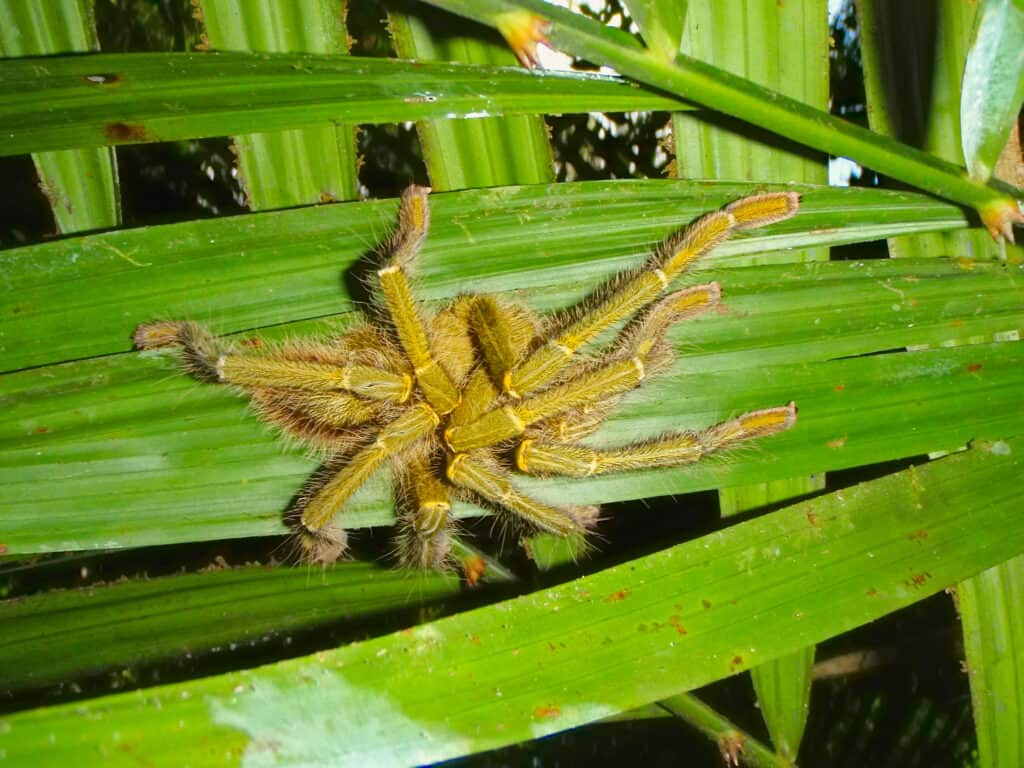
The Malaysian earthtiger tarantula is a species of spider in the family Theraphosidae (tarantulas),
©MikeZuluNovember/Shutterstock.com
This is a large and colorful tarantula species native to Malaysia. Because of their aggressive and defensive nature, the Malaysian earthtiger don’t make very great pets.
Togo Starburst Baboon (Heteroscodra maculata)

Togo Starburst (
Heteroscodra maculata) tarantulas are tree dwellers, but juveniles burrow occasionally.
©SteveSimonsPhotography/Shutterstock.com
If you’re keeping a Togo starburst baboon as a pet, you should avoid handling the spider with your hands as they have highly potent venom. They’re tree dwellers, but juveniles burrow occasionally.
Singapore Blue (Lampropelma violaceopes)
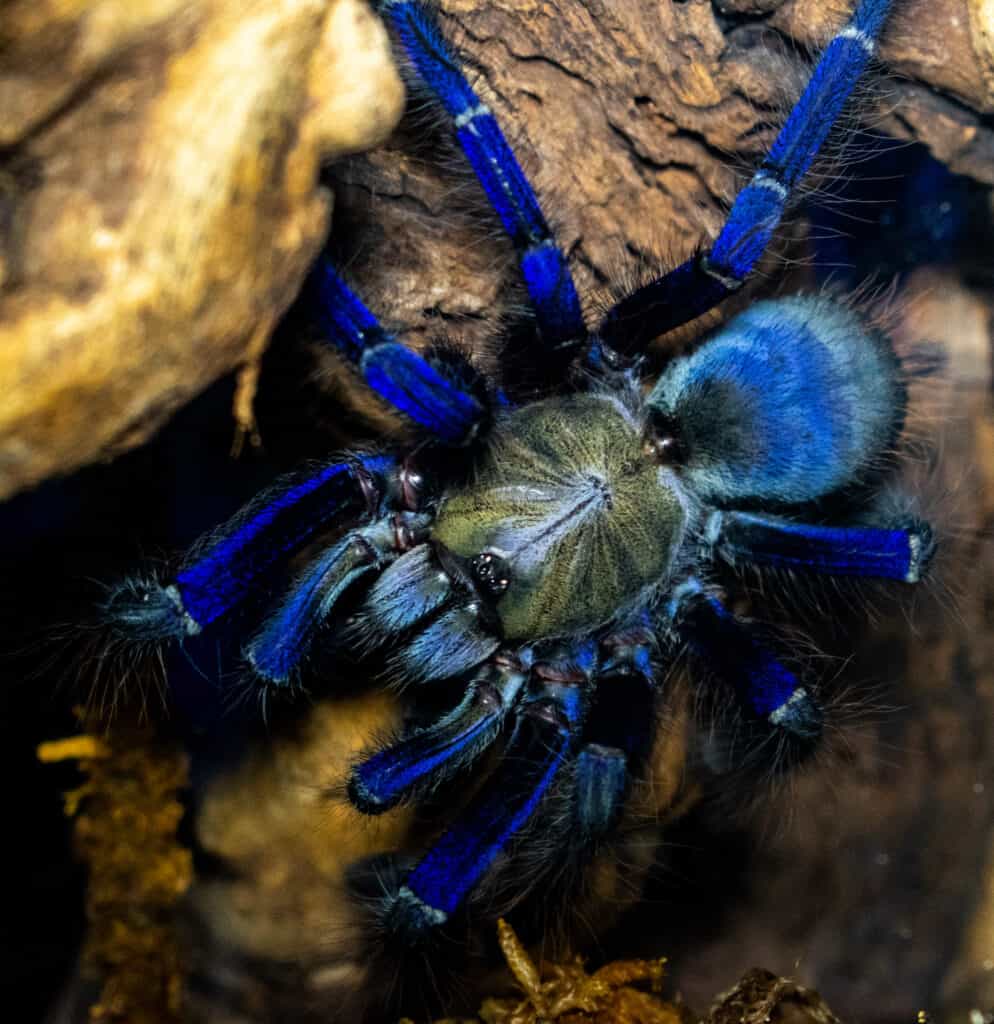
The Singapore blue tarantula can deliver a painful bite when disturbed.
©Blake Frye/Shutterstock.com
The Singapore blue tarantula has a brown or golden colored body with deep blue legs. Their beautiful color is the major reason they’re popular as pets, but this spider can deliver a painful bite when disturbed.
Peacock Tarantula (Poecilotheria metallic)
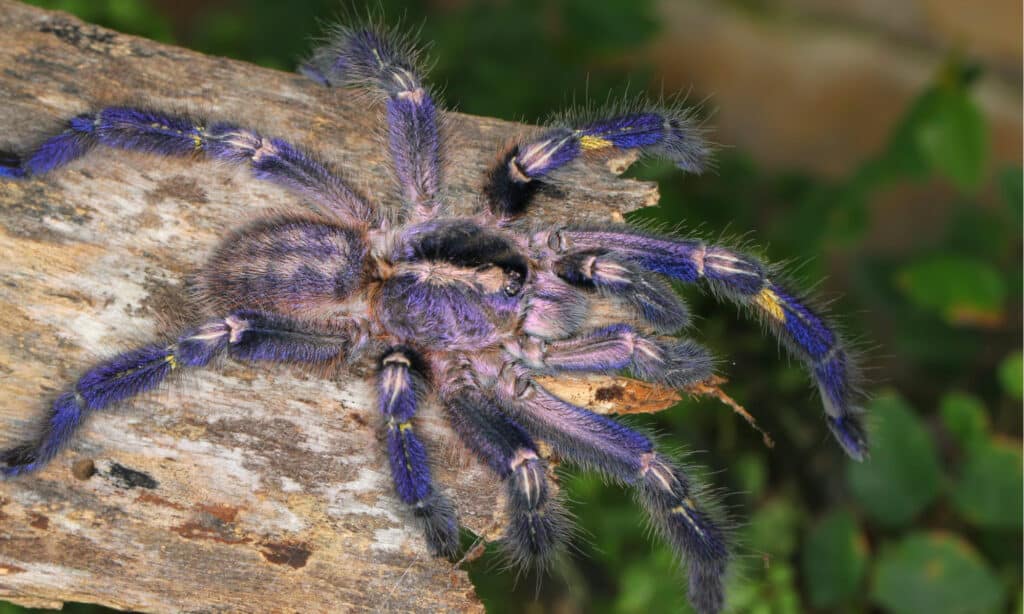
The peacock tarantula is photosensitive and tends to hide when disturbed.
©Pong Wira/Shutterstock.com
This tarantula species is characterized by intricate body coloration with a geometric arrangement that gives it a very impressive appearance. It is photosensitive and tends to hide when disturbed. However, this spider can get quite defensive.
Other Aggressive Old World Tarantula Species
- Feather Leg Baboon (Stromatopelma calceatum)
- Fringed Ornamental (Poecilotheria ornata)
- Mysore Ornamental (Poecilotheria striata)
- Indian Ornamental (Poecilotheria regalis)
How Many Species of Tarantula Are There?

The Goliath tarantula has inch-long fangs that inject toxins into a preys bloodstream. It is the largest tarantula species.
©Milan Zygmunt/Shutterstock.com
Tarantulas are a family of arachnids known for their considerable size and frequently hairy appearance. As of August 2022, researchers have identified a total of 1,040 distinct species belonging to 156 different genera within this group.
The Gooty Sapphire Ornamental Tarantula, known for its striking appearance, is a rare spider found in India, specifically in the southern region of Andhra Pradesh. It’s a critically endangered species that has been successfully bred in captivity for about ten years.
Additionally, the Goliath Birdeater (Theraphosa blondi) is a member of the Theraphosidae tarantula family and is native to northern South America. It holds the title of the world’s largest spider in terms of both mass (6.2 oz) and body length (5.1 in). It ranks second in leg span only to the giant huntsman spider.
The photo featured at the top of this post is © tempisch/Shutterstock.com
Sources
- The Arena Media Brands, Available here: https://pethelpful.com/exotic-pets/Tarantulas-by-ExperienceDifficulty-Level
- Pet Keen, Available here: https://petkeen.com/tarantula-species-that-make-great-pets/
- The Spruce Pets, Available here: https://www.thesprucepets.com/best-pet-tarantula-species-4176793
- EverythingReptiles, Available here: https://www.everythingreptiles.com/pet-tarantulas/
Thank you for reading! Have some feedback for us? Contact the AZ Animals editorial team.






